7.5: Voice From the Past: What Fossils Can Tell Us
- Last updated
- Save as PDF
- Page ID
- 67484
Given that so few organisms ever become fossilized, any anthropologist or fossil hunter will tell you that finding a fossil is extremely exciting. But this is just the beginning of a fantastic mystery. With the creative application of scientific methods and deductive reasoning, a great deal can be learned about the fossilized organism and the environment in which it lived, leading to enhanced understanding of the world around us.
Dating Methods
Context is a crucial concept in paleoanthropology and archaeology. Objects and fossils are interesting in and of themselves, but without context there is only so much we can learn from them. One of the most important contextual pieces is the dating of an object or fossil. By being able to place it in time, we can compare it more accurately with other contemporary fossils and artifacts or we can better analyze the evolution of a fossil species or artifacts. To answer the question “How do we know what we know?” you have to know how archaeologists and paleoanthropologists establish dates for artifacts, fossils, and sites.
Dating techniques are divided into two broad categories: relative dating methods and chronometric (sometimes called absolute) dating methods.
Relative Dating
Relative dating methods are the first used because they rely on simple observational skills. In the 1820s, Christian Jürgensen Thomsen at the National Museum of Denmark in Copenhagen developed the “three-age” system still used in European prehistory today (Feder 2017, 17). He categorized the artifacts at the museum based on the idea that simpler tools and materials were most likely older than more complex tools and materials. Stone tools must predate metal tools because they do not require special technology to develop. Copper and bronze tools must predate iron because they can be smelted or worked at lower temperatures, etc. Based on these observations, he categorized the artifacts into Stone Age, Bronze Age, and Iron Age.
The restriction of relative dating is that you don’t know specific dates or how much time passed between different sites or artifacts. You simply know that one artifact or fossil is older than another. Thomsen knew that Stone Age artifacts were older than Bronze Age artifacts, but he couldn’t tell if they were hundreds of years older or thousands of years older. The same is true with fossils that have differences of ages into the hundreds of millions of years.
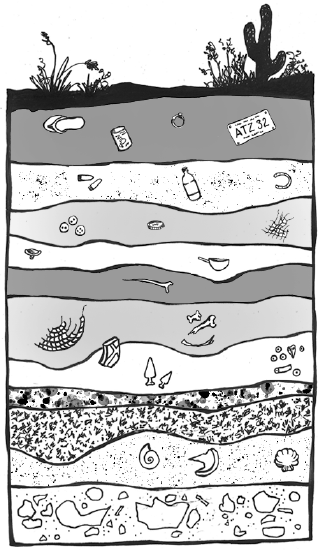 Figure \(\PageIndex{1}\): An illustration of a stratigraphic cross-section. The objects at a lower strata are older than the one above.
Figure \(\PageIndex{1}\): An illustration of a stratigraphic cross-section. The objects at a lower strata are older than the one above.The first relative dating technique is stratigraphy (Figure 7.28). You might have already heard this term if you have watched documentaries on archaeological excavations. That’s because it is still being used today. It provides a solid foundation for other dating techniques to be used and gives important context to artifacts and fossils found at a site.
Stratigraphy is based on the Law of Superposition first proposed by Nicholas Steno in 1669 and further explored by James Hutton (the previously mentioned “Father” of Deep Time). Essentially, superposition tells us that things on the bottom are older than things on the top (Williams 2004, 28). Notice on Figure 7.28 that there are distinctive layers piled on top of each other. It stands to reason that each layer is older than the one immediately on top of it (Hester et al. 1997, 338). Think of a pile of laundry on the floor. Over the course of a week, as dirty clothes get tossed on that pile, the shirt tossed down on Monday will be at the bottom of the pile while the shirt tossed down on Friday will be at the top. Assuming that the laundry pile was undisturbed throughout the week, if the clothes were picked up layer by layer, the clothing choices that week could be reconstructed in the order that they were worn. This concept may seem simple or even obvious, but it is extremely important in archaeology.
Another important relative dating technique is biostratigraphy. This form of dating looks at the context of a fossil or artifact and compares it to the other fossils and biological remains (plant and animal) found in the same stratigraphic layers. For instance, if an artifact is found in the same layer as wooly mammoth remains, you know that it must date to around the last ice age, when wooly mammoths were still abundant on Earth. In the absence of more specific dating techniques, early archaeologists could prove the great antiquity of stone tools because of their association with extinct animals. The application of this relative dating technique in archaeology was used at the Folsom site in New Mexico. Ever since Europeans encountered people in the Americas, they wondered how long they had been on the continent. Were they recent arrivals from Asia or had their ancestors been there thousands of years? Biostratigraphy helped answer this question before absolute dating techniques had even been invented. In 1927, at a site in Folsom, New Mexico, a stone spear point was discovered embedded in the rib of an extinct species of bison. Because of the undeniable association between the artifact and the ancient animal, there was proof that people had occupied the North American continent since antiquity (Cook 1928).
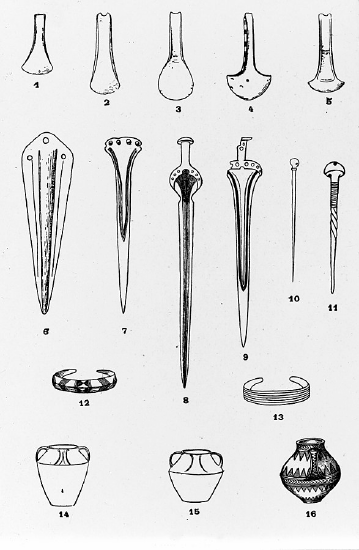 Figure \(\PageIndex{2}\): Charts of typology, like these representing items from the Bronze Age, are used to classify artifacts and illustrate cultural material assemblages.
Figure \(\PageIndex{2}\): Charts of typology, like these representing items from the Bronze Age, are used to classify artifacts and illustrate cultural material assemblages.Similar to biostratigraphic dating is cultural dating (Figure 7.29). This relative dating technique is used to identify the chronological relationships between human-made artifacts. Cultural dating is based on artifact types and styles (Hester et al. 1997, 338). For instance, a pocket knife by itself is difficult to date. However, if the same pocket knife is discovered surrounded by cassette tapes and VHS tapes, it is logical to assume that the artifact came from the 1980s or 1990s like the cassette and VHS tapes. The pocket knife could not be dated earlier than the age of the cassette and VHS tapes because the tapes were made no earlier than the 1980s. In the Thomsen example above, he was able to identify a relative chronology of ancient European tools based on the artifact styles, manufacturing techniques, and raw materials. Cultural dating can be used with any human-made artifacts. Both cultural dating and biostratigraphy are most effective when you are already familiar with the time periods for the artifacts and animals. They are still used today to identify general time periods for sites.
Chemical dating was developed in the 19th century and represents one of the early attempts to use soil composition and chemistry to date artifacts. A specific type of chemical dating is fluorine dating, and it is commonly used to compare the age of the soil around artifacts located in close proximity (Cook and Ezra-Cohn 1959). While this technique is based on chemical dating, it only provides the relative dates of items rather than their absolute ages. For this reason, fluorine dating is considered a hybrid form of relative and chronometric dating methods (discussed below).
Soils contain different amounts of chemicals, and those chemicals, such as fluorine, can be absorbed by human and animal bones buried in the soil. The longer the remains are in the soil, the more fluorine they will absorb (Cook and Ezra-Cohn 1959). Unfortunately, this absorption rate is highly sensitive to temperature, soil pH, and varying fluorine levels in local soil and groundwater (Haddy and Hanson 1982). This makes it difficult to get an accurate date for the remains or to compare remains between two sites. However, this technique is particularly useful for determining whether different artifacts come from the same burial context. If they were buried in the same soil for the same length of time, their fluorine signatures would match.
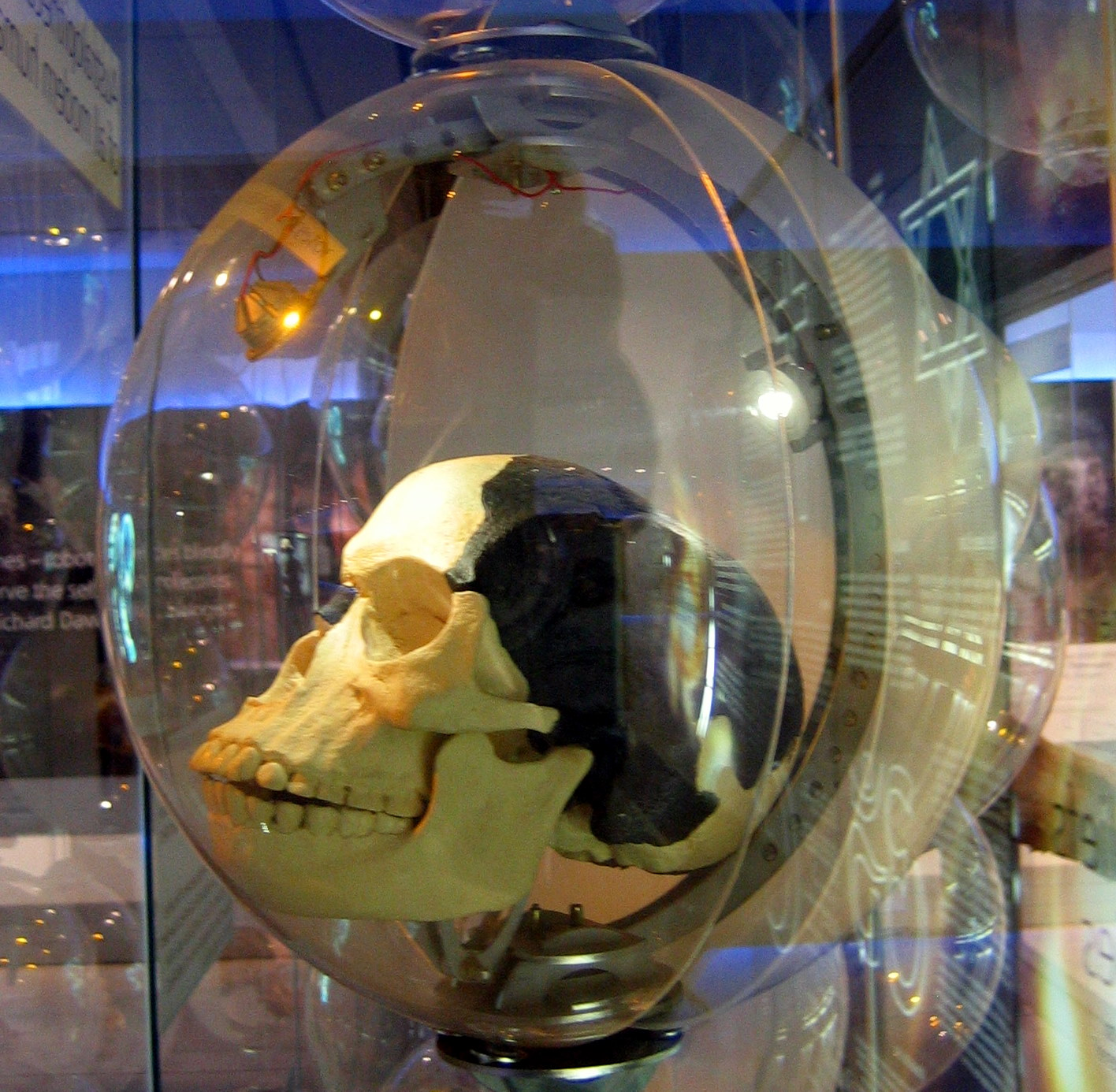 Figure \(\PageIndex{3}\): The Piltdown Man forgery that confused scientists for 40 years.
Figure \(\PageIndex{3}\): The Piltdown Man forgery that confused scientists for 40 years.The fluorine technique was used to identify the famous archaeological forgery,“Piltdown Man” (Figure 7.30). In 1912, Charles Dawson of England “discovered” Piltdown Man, or Eoanthropus dawsoni. In addition to bringing worldwide attention to British anthropology, Dawson himself became famous for his discovery. As a fossil specimen, Piltdown Man had a large bulbous cranium like modern humans, but a primitive apelike jaw and teeth. These characteristics helped Dawson convince many in the field of anthropology that his fossil was the “missing link” between apes and humans. Dawson’s find also served as incontrovertible evidence for a European origin of human evolution, a hypothesis that favored Western-imposed thought and superiority. Because Dawson’s discovery was accepted for over 40 years, many researchers became skeptical of the newer finds coming out of South Africa that did not share the same unique characteristics as Eoanthropus (De Groote et al. 2016). However, as more and more of the human African fossils began emerging, scientists began to suspect Piltdown Man was not the missing link as it had been represented and the credibility of Eoanthropus was brought into scrutiny.
It was not until after Dawson’s death that outside researchers were able to access the remains and conduct independent analysis on them. They noticed that the teeth had odd wear patterns on them. Dawson had filed them down to better fit the mandible to the maxilla. Fluorine analysis determined that the jaw and cranium had different fluorine signatures. Thus, these bones could not have come from the same individual in the same burial environment. It turned out that the cranium was from two, maybe three, medieval humans and the jaw from a modern Bornean orangutan, Pongo pygmaeus (De Groote et al. 2016). Furthermore, all of the pieces of the cranium were stained to give a uniform and ancient-looking color. Piltdown Man was a forgery that greatly disrupted legitimate anthropological research and confused the understanding of the fossil record in the early 20th century.
Chronometric Dating
Unlike relative dating methods, chronometric dating methods provide specific dates and time ranges. Many of the chronometric techniques we will discuss are based on work in other disciplines such as chemistry and physics. The modern developments in studying radioactive materials are extremely accurate and precise in establishing dates for ancient sites and remains.
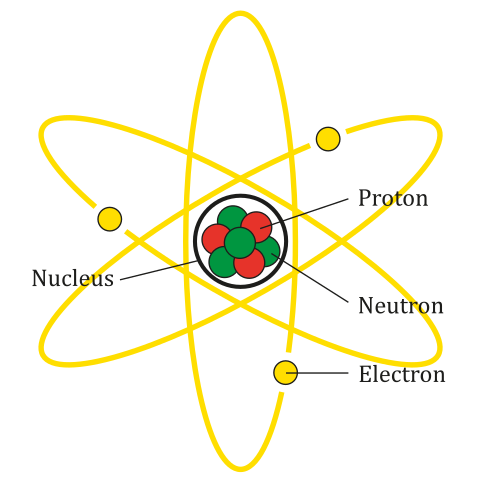 Figure \(\PageIndex{4}\): Simplified illustration of an atom.
Figure \(\PageIndex{4}\): Simplified illustration of an atom.Many of the chronometric dating methods are based on the measurement of radioactive decay of particular elements. Elements are materials that cannot be broken down into more simple materials without losing their chemical identity (Brown et al. 2018, 48). Each element consists of an atom that has a specific number of protons (positively charged particles) and electrons (negatively charged particles) as well as varying numbers of neutrons (particles with no charge). The protons and neutrons are located in the densely compacted nucleus of the atom, but the majority of the volume of an atom is space outside the nucleus around which the electrons orbit (see Figure 7.31).
Elements are classified based on the number of protons in the nucleus. For example, carbon has six protons, giving it an atomic number 6. Uranium has 92 protons, which means that it has an atomic number 92. While the number of protons in the atom of an element do not vary, the number of neutrons may. Atoms of a given element that have different numbers of neutrons are known as isotopes.
The majority of an atom’s mass is determined by the protons and neutrons, which have more than a thousand times the mass of an electron. Due to the different numbers of neutrons in the nucleus, isotopes vary by nuclear/atomic weight (Brown et al. 2018, 94). For instance, isotopes of carbon include carbon 12 (12C), carbon 13 (13C), and carbon 14 (14C). Carbon always has six protons, but 12C has six neutrons whereas 14C has eight neutrons. Because 14C has more neutrons, it has a greater mass than 12C (Brown et al. 2018, 95).
Most isotopes in nature are considered stable isotopes and will remain in their normal structure indefinitely. However, some isotopes are considered unstable isotopes (sometimes called radioisotopes) because they spontaneously release energy and particles, transforming into stable isotopes (Brown et al. 2018, 946; Flowers et al. 2018, section 21.1). The process of transforming the atom by spontaneously releasing energy is called radioactive decay. This change occurs at a predictable rate for nearly all radioisotopes of elements, allowing scientists to use unstable isotopes to measure time passage from a few hundred to a few billion years with a large degree of accuracy and precision.
The leading chronometric method for archaeology is radiocarbon dating (Figure 7.32). This method is based on the decay of 14C, which is an unstable isotope of carbon. It is created when nitrogen 14 (14N) interacts with cosmic rays, which causes it to convert to 14C. Carbon 14 in our atmosphere is absorbed by plants during photosynthesis, a process by which light energy is turned into chemical energy to sustain life in plants, algae, and some bacteria. Plants absorb carbon dioxide from the atmosphere and use the energy from light to convert it into sugar that fuels the plant (Campbell and Reece 2005, 181–200). Though 14C is an unstable isotope, plants can use it in the same way that they use the stable isotopes of carbon.
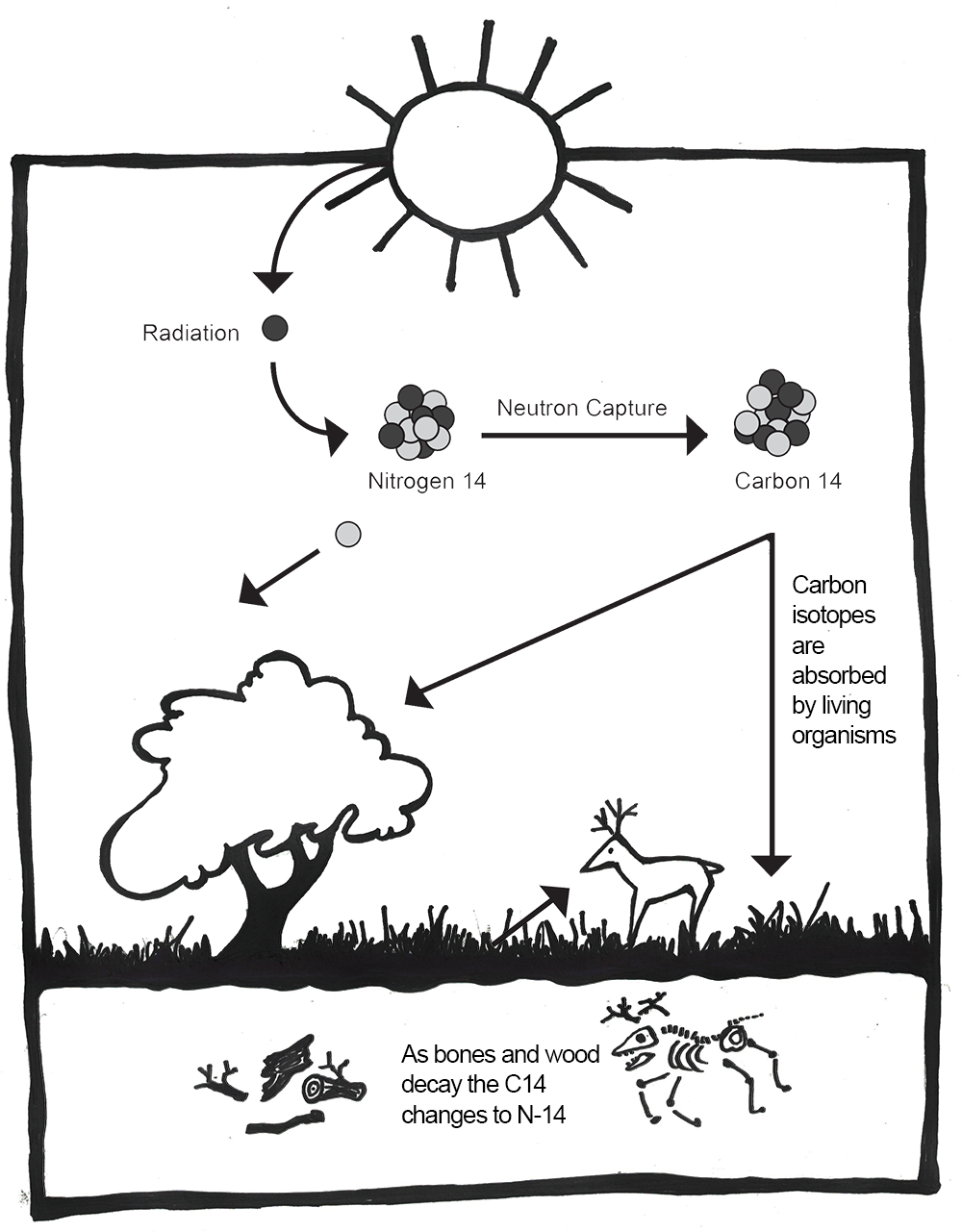 Figure \(\PageIndex{5}\): A graphic illustrating how 14C is created in the atmosphere, absorbed by living organisms, and ends up in the archaeological record.
Figure \(\PageIndex{5}\): A graphic illustrating how 14C is created in the atmosphere, absorbed by living organisms, and ends up in the archaeological record.Animals get the 14C by eating the plants. Humans take it in by eating plants and animals. Carbon 14 has a half-life of 5,730 years (Hester et al. 1997, 324). That means that in 5,730 years, half the amount of 14C will have converted back into 14N. Because the pattern of radioactive decay is so reliable, we can use 14C to accurately date sites up to 50,000 years old. However, 14C can only be used on the remains of biological organisms. This includes shell, wood, plant material, and bone.
As mentioned before, 14C is unstable and ultimately decays back into 14N. This decay is happening at a constant rate (even now inside your own body!). However, as long as an organism is alive and taking in food, 14C is being replenished in the body. As soon as an organism dies, it no longer takes in new 14C. We can then use the rate of decay to measure how long it has been since the organism died (Hester et al. 1997, 324).
An example of this is the use of 14C to date burials. For instance, at the Iron Age site of Wetwang Slack in East Yorkshire, England, a selection of burials across the site were dated directly with 14C. By choosing a range of burials, archaeologists were able to identify the length of time the cemetery was used as well as different phases of use (Dent 1982). Because we can assume that any artifacts found with the bodies were placed there at the time of burial, we can estimate the age of the artifacts even though the bones were the only things directly dated.
As you will see in the hominin chapters, 50,000 years is only a tiny fragment of human evolutionary history. It is insignificant in the context of the age of our planet. In order to date even older fossils, other methods of dating are necessary. Some of these are also based on radioactive decay.
and can reach further back into the past than radiocarbon dating. Used to date volcanic rock, these techniques are based on the decay of unstable potassium 40 (40K) into argon 40 (40Ar) gas, which gets trapped in the crystalline structures of volcanic material. It’s important to note that this form of dating is not done directly on the fossil in which you are interested. This is where stratigraphy becomes important. The K-Ar method dates the layers around the fossil to give approximate dates for when that fossil was deposited. The benefit of this dating technique is that 40K has a half-life of circa 1.3 billion years, so it can be used on sites as young as 100 kya and as old as the age of Earth. As you will see in later chapters, it is particularly useful in dating early hominin sites in Africa (Michels 1972, 120; Renfrew and Bahn 2016, 155).
 Figure \(\PageIndex{6}\): Thin section showing damage tracks from fission.
Figure \(\PageIndex{6}\): Thin section showing damage tracks from fission.Fission track dating is another useful dating technique for sites that are millions of years old. This is based on the decay of radioactive uranium 238 (238U). The unstable atom of 238U fissions at a predictable rate. The fission takes a lot of energy and causes damage to the surrounding rock (see Figure 7.33). For instance, in volcanic glasses we can see this damage as trails in the glass. Researchers in the lab count the number of fission trails using an optical microscope. As 238U has a half-life of 4,500 million years, it can be used to date rock and mineral material starting at just a few decades and extending back to the age of Earth. As with K-Ar, archaeologists are not dating artifacts directly. They are dating the layers around the artifacts in which they are interested (Laurenzi et al. 2007).
Luminescence dating, which includes thermoluminescence and a related technique called optically stimulated luminescence, is based on the naturally occurring background radiation in soils. Pottery, baked clay, and sediments that include quartz and feldspar are bombarded by radiation from the soils surrounding it. Electrons in the material get displaced from their orbit and trapped in the crystalline structure of the pottery, rock, or sediment. When heated to 500°C (thermoluminescence) or exposed to particular light wavelengths (optically stimulated luminescence) in the laboratory, this energy gets released in the form of light and heat and can be measured (Cochrane et al. 2013; Renfrew and Bahn 2016, 160). You can use this method to date artifacts like pottery and burnt flint directly. When attempting to date fossils, you may use this method on the crystalline grains of quartz and feldspar in the surrounding soils (Cochrane et al. 2013). The important thing to remember with this form of dating is that heating the artifact or soils will reset the clock. The method is not necessarily dating when the object was last made or used but when it was last heated to 500°C or more (pottery) or exposed to sunlight (sediments). Luminescence dating can be used on sites from less than 100 years to over 100,000 years (Duller 2008, 4). As with all archaeological data, context is crucial to understanding the information.
Like thermoluminescence dating, electron spin resonance dating is based on the measurement of accumulated background radiation from the burial environment. It is used on artifacts and rocks with crystalline structures, including tooth enamel, shell, and rock—those for which thermoluminescence would not work. The radiation causes electrons to become dislodged from their normal orbit. They become trapped in the crystalline matrix and affect the electromagnetic energy of the object. This energy can be measured and used to estimate the length of time in the burial environment. This technique works well for remains as old as two million years (Carvajal et al. 2011, 115–116). It has the added benefit of being nondestructive, which is an important consideration when dealing with irreplaceable material.
Not all chronometric dating methods are based on unstable isotopes and their rates of decay. There are several other methods that make use of other natural biological and geologic processes. One such method is known as dendrochronology (Figure 7.34). It is based on the natural growth patterns of trees. As most of you probably learned in elementary school, trees create concentric rings as they grow. The width of those rings depends on environmental conditions and season. In a perfect world, you can tell the age of a tree by counting the rings. You can also see a record of rainfall, droughts, and forest fires using the rings.
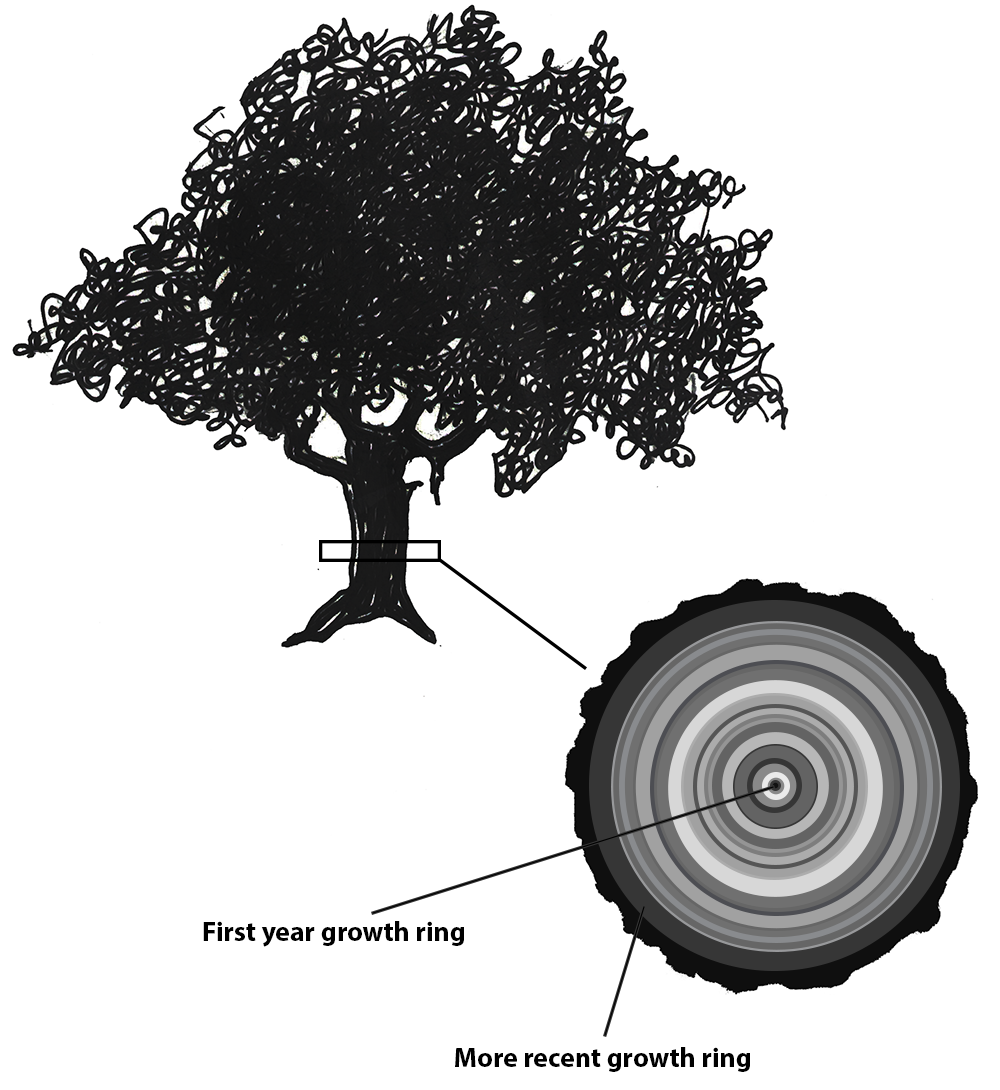
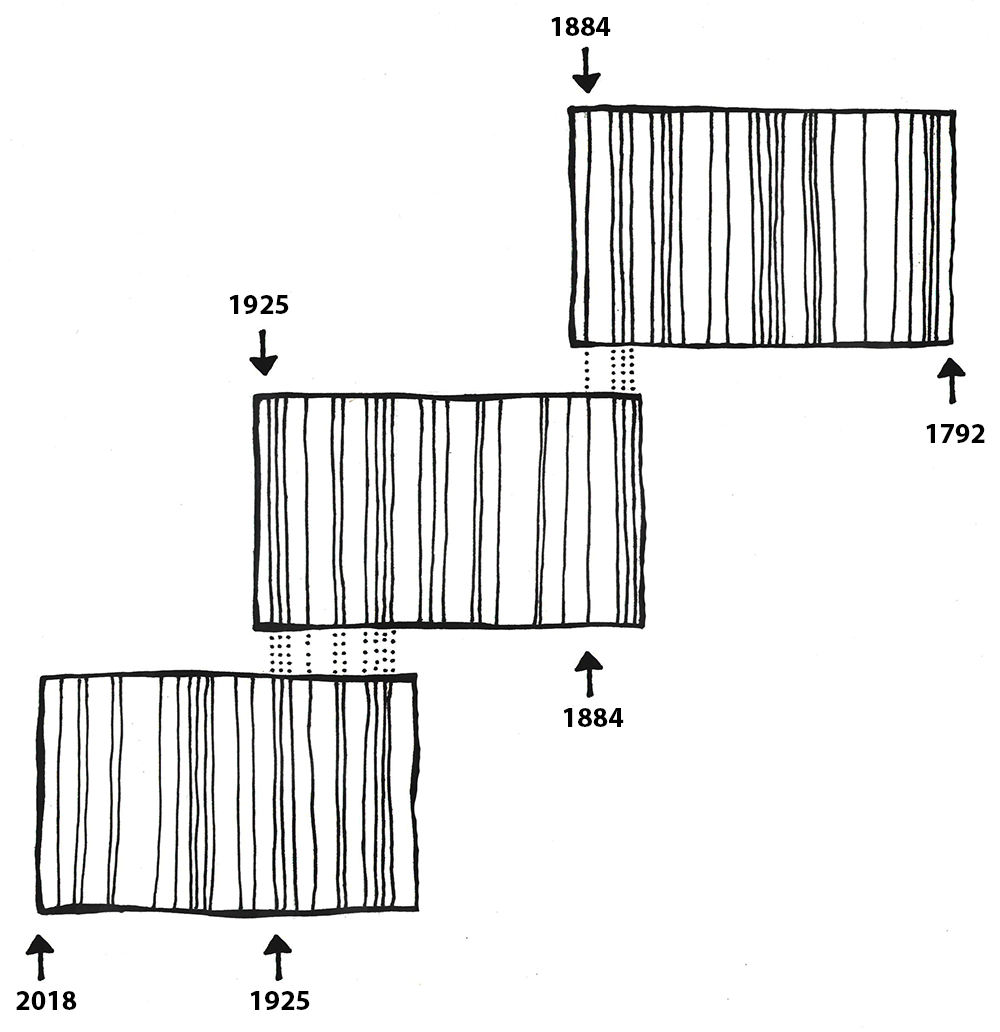 Figure \(\PageIndex{7}\): Dendrochronology uses the variations in tree rings to create timelines.
Figure \(\PageIndex{7}\): Dendrochronology uses the variations in tree rings to create timelines.Tree rings can be used to date wood artifacts from ancient sites. First, archaeologists need to create a profile of trees in a particular area. They start with modern trees and identify patterns in ring growth. Then, they overlap these patterns with slightly older trees to extend the timeline back. These tree patterns can be overlapped back in time as long as there are intact tree rings available. The Northern Hemisphere chronology stretches backs nearly 14,000 years (Reimer et al. 2013, 1870). Archaeologists can then compare wood artifacts with existing timelines and find where their artifacts fit in the pattern.
This method, however, is not foolproof. Growth can be interrupted so that tree rings do not correspond exactly with the tree’s age. Microclimates and tree species variation can also alter growth patterns. However, dendrochronologists can work around these issues using multiple samples, statistical analysis, and calibration with other dating methods. Additionally, for this method to work, the artifact must be preserved well enough to have visible tree rings to analyze. The results of the analysis will tell you an approximate time that the tree lived. To know exactly when the tree was cut down, the outer rings and bark should be present. But despite these limitations, dendrochronology can be a powerful tool in dating archaeological sites (Hillam et al. 1990; Kuniholm and Striker 1987).
Dendrochronology has been in use since the early 20th century (Dean 2009, 25). It has been used successfully to date southwestern U.S. sites such as Pueblo Bonito and Aztec Ruin (Dean 2009, 26). In Europe during the mid-20th century, archaeologists built chronologies that spanned thousands of years. The dendrochronological evidence helped calibrate radiocarbon dates and even provided direct evidence of global warming (Dean 2009, 26–27).
Amino acid racemization (AAR) is a dating method that is used for organic materials such as bones, teeth, and shell. Organic tissues include amino acids that help build their structures. The molecular structure of amino acids occurs in two forms (isomers), “D (dextrorotatory) and L (levorotatory) forms” (Komutrattananont and Mahakkanukrauh 2017). These forms (referred to as enantiomers) have molecular structures that are mirror images of each other under polarized light. During life, most amino acids are in the L-form. However, upon the death of an organism the amino acids flip to the mirror image or D-form. This switch happens at a predictable rate and, like radiocarbon dating, can be a useful measure of time elapsed since the organism’s death. Its usable time range extends well beyond that of radiocarbon dating and can be used on remains over a million years old (Renfrew and Bahn 2016, 163). However, AAR is sensitive to temperature, so it is important know the relative temperature fluctuations of the site or the results will not be reliable.
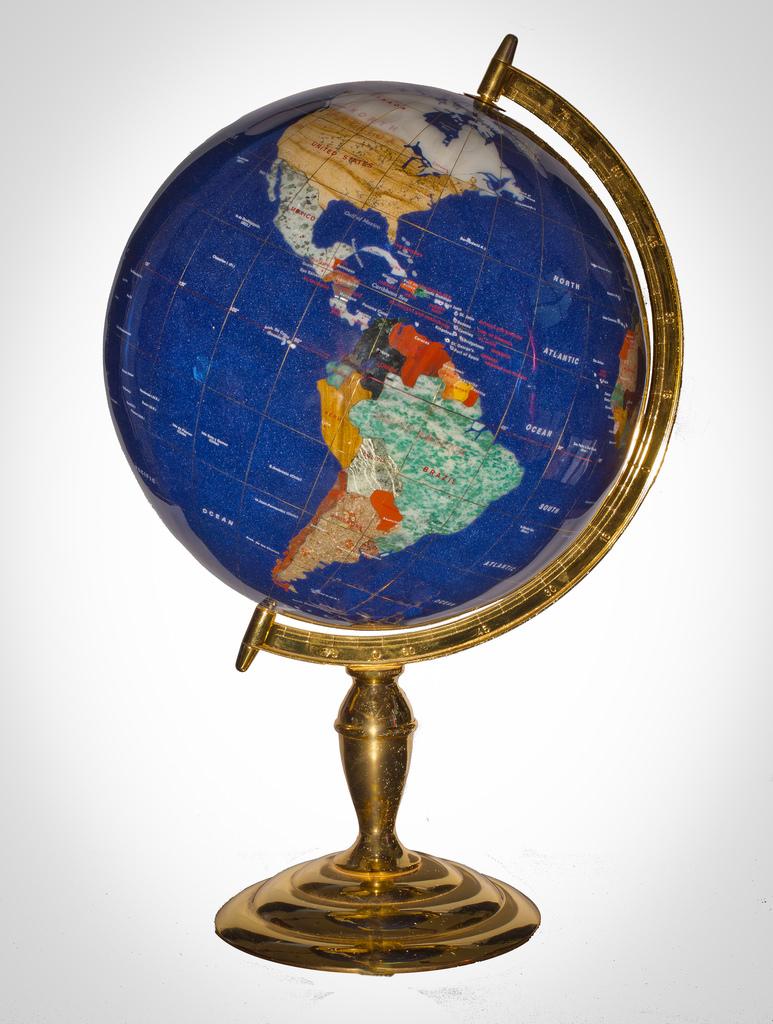 Figure \(\PageIndex{8}\): The classroom globe reflecting planet Earth as a perfect sphere with an axis that bisects the points known as Geographic North and Geographic South.
Figure \(\PageIndex{8}\): The classroom globe reflecting planet Earth as a perfect sphere with an axis that bisects the points known as Geographic North and Geographic South.Finally, we have . This is a fairly easy concept, but it takes a bit of explanation because it is easy to confuse geographic positions with geomagnetism. Most people are aware that the North Pole occurs at the Arctic Circle and the South Pole occurs at the Antarctic Circle. The typical classroom globe reinforces this concept because it typically has a rod inserted through the middle of the sphere that attaches the globe to its stand (Figure 7.35). The rod is an imaginary axis on which Earth supposedly spins, and because it enters the globe at Latitude 90° N., this point is called Geographic North. The coordinates for the south pole are just the opposite or 90° S., Geographic South.
However, for planet Earth, the poles are actually magnetic fields, and geomagnetic poles are not located at the same places as geographic poles. Just to complicate the matter, magnetic poles move around. Fortunately, scientists have been able to chart these movements since 1899. According to Randy Russell (2007), in the early 20th century, there was about 9 km of movement per year. However, by 1970, the movement sped up significantly, to 41 km per year. The impact of human activity with global warming and the melting of glacial mass loss continues to speed up this movement (Adhikari and Ivins 2016). Eventually, the geomagnetic north and south poles will swap, an event called a paleomagnetic or geomagnetic reversal. As radical as that seems, it’s important to remember that these reversals have occurred many times, typically every couple of hundreds of thousands of years over the course of long history of the earth. Obviously, there are implications to reversal. The clearest is that compasses will not work as expected. Animals may become disoriented, at least at first (Drake 2018). Furthermore, some scientists predict an increase in solar flares that will create holes in the ozone layer, likely resulting in increased instances of skin cancer and interference with satellite technology (Valet and Valladas 2010; Wolchover 2012). But it is not all bad news. The beautiful green and purple skies created by the aurora borealis or “Northern Lights” will be increasingly visible at southern latitudes as the geomagnetic reversal progresses (Drake 2018). However, there is a great deal of debate regarding impacts of geomagnetic reversals on the planet and studies are ongoing.
When the poles do reverse, we can identify it in the geologic record by analyzing volcanic rock. Iron minerals in volcanic material align themselves with the poles’ positions at the time the volcanic material is still molten. When the material cools and hardens, those minerals are locked into place. They give us a glimpse of the poles’ locations at the time the rock cooled (Gubbins 2008). These events can be correlated with other dating methods and are used to identify broad time periods (sometimes lasting tens to hundreds of thousands of years) of particular layers of interest.
Environmental Reconstruction
Another important part of understanding human evolution (and evolution in general) is understanding the way in which an organism’s environment affects its survival. As you read in chapter 2, Darwin, Lamarck, Wallace, and others recognized the importance of the environment in shaping the evolutionary course of animal species. To understand what selective processes might be shaping evolutionary change, we must be able to reconstruct the environment in which the organism was living.
One of the ways to do that is to look at the plant species that lived in the same time range as the species in which you are interested. One way to identify ancient flora is to analyze sediment cores from water and other protected sources. Pollen gets released into the air and some of that pollen will fall on wetlands, lakes, caves, and so forth. Eventually it sinks to the bottom of the lake and forms part of the sediment. This happens year after year, so subsequent layers of pollen build up in an area, creating strata. By taking a core sample and analyzing the pollen and other organic material, an archaeologist can build a timeline of plant types and see changes in the vegetation of the area (Hester et al. 1997, 284). This can even be done over large areas by studying ocean bed cores, which accumulate pollen and dust from large swaths of neighboring continents.
Another way of reconstructing past environments is by using stable isotopes. Unlike unstable isotopes, stable isotopes remain constant in the environment throughout time. Plants take in the isotopes through photosynthesis and ground water absorption. Animals take in isotopes by drinking local water and eating plants. Stable isotopes can be powerful tools for identifying where an organism grew up and what kind of food the organism ate throughout its life. They can even be used to identify global temperature fluctuations.
Global Temperature Reconstruction
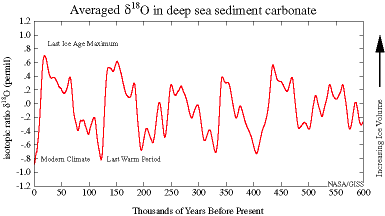 Figure \(\PageIndex{9}\): The temperatures of the sea have fluctuated greatly over the course of the history of the planet.
Figure \(\PageIndex{9}\): The temperatures of the sea have fluctuated greatly over the course of the history of the planet.Oxygen isotopes are a powerful tool in tracking global temperature fluctuations throughout time. The isotopes of Oxygen 18 (18O) and Oxygen 16 (16O) occur naturally in Earth’s water. Both are stable isotopes, but 18O has a heavier atomic weight. In the normal water cycle, evaporation takes water molecules from the surface to the atmosphere. Because 16O is lighter, it is more likely to be part of this evaporation process. The moisture gathers in the atmosphere as clouds that eventually may produce rain or snow and release the water back to the surface of the planet. During cool periods like glacial periods (ice ages), the evaporated water often comes down to Earth’s surface as snow. During these periods, snow piles up in the winter but, because of the cooler summers, does not melt off. Instead, the snow gets compacted and layered year after year, eventually resulting in large glaciers or ice sheets covering parts of Earth. Since 16O, with the lighter atomic weight, is more likely to be absorbed in the evaporation process, it gets locked up in glacier formation. The waters left in oceans would have a higher ratio of 18O during these periods of cooler global temperatures (Potts 2012, 154–156; see Figure 7.36).
The microorganisms that live in the oceans, foraminifera, absorb the water from their environment and use the oxygen isotopes in their body structures. When these organisms die, they sink to the ocean floor, contributing to the layers of sediment. Scientists can extract these ocean cores and sample the remains of foraminifera for their 18O and 16O ratios. These ratios will give a good approximation of global temperatures deep into the past. Cooler temperatures indicate higher ratios of 18O (Potts 2012, 154–156).
Diet Reconstruction
Stable isotopes can also be used to reconstruct animal diet and migration patterns. The concept is “you are what you eat.” Living organisms absorb elements from ingested plants and water. These elements are used in tissues like bones, teeth, skin, hair, and so on. By analyzing the stable isotopes in the bones and teeth of humans and other animals, we can identify the types of food they ate at different stages of their lives as well as where they lived.
Plants take in carbon dioxide from the atmosphere during photosynthesis. We’ve already discussed this using the example of the unstable isotope 14C; however, this absorption also takes place with the stable isotopes of 12C and 13C. During photosynthesis, some plants incorporate carbon dioxide as a three-carbon molecule (C3 plants) and some as a four-carbon molecule (C4 plants). On the one hand, C3 plants include certain types of trees and shrubs that are found in relatively wet environments and have lower ratios of 13C compared to 12C. C4 plants, on the other hand, include plants from drier environments like savannahs and grasslands. C4 plants have higher ratios of 13C to 12C than C3 plants (Renfrew and Bahn 2016, 312). These ratios remain stable as you go up the food chain. Therefore, you can analyze the bones and teeth of an animal to identify the 13C/12C ratios and identify the types of plants that animal was eating.
The ratios of stable nitrogen isotopes 15N and 14N can also give information about the diet of fossilized or deceased organisms. Though initially absorbed from water and soils by plants, the nitrogen ratios change depending on the primary diet of the organism. An animal who has a mostly vegetarian diet will have lower ratios of 15N to 14N, while those further up the food chain, like carnivores, will have higher ratios of 15N. Interestingly, breastfeeding infants have a higher nitrogen ratio than their mothers, because they are getting all of their nutrients through their mother’s milk. So nitrogen can be used to track life events like weaning (Jay et al. 2008, 2). A marine versus terrestrial diet will also affect the nitrogen signatures. Terrestrial diets have lower ratios of 15N than marine diets. In the course of human evolution, this type of analysis can help us identify important changes in human nutrition. It can help anthropologists figure out when meat became a primary part of the ancient human diet or when marine resources began to be used. The ratios of stable nitrogen isotopes can also be used to determine a change in status, as in the case of the Llullaillaco children (the “ice mummies”) found in the Andes Mountains (Wilson et al. 2007). Although the two younger children had little changes in their diets in the last year of their short lives, the changes in their nitrogen values were significant enough to suggest that the improvement in their diets may have been attributed to the Incas’ desire to sacrifice healthy, high-status children” (Faux 2012, 6).
Migration
Stable isotopes can also tell a great deal about where an individual lived and whether they migrated during their lifetime. The geology of Earth varies because rocks and soils have different amounts or ratios of certain elements in them. These variations in the ratios of isotopes of certain elements are called isotopic signatures. They are like a chemical fingerprint for a geographical region. These isotopes get into the groundwater and are absorbed by plants and animals living in that area. Elements like strontium, oxygen, and nitrogen, among others, are then used by the body to build bones and teeth. If you ate and drank local water all of your life, your bones and teeth would have the same isotopic signature as the geographical region in which you lived.
However, most people (and animals) move around during their lifetimes. Isotopic signatures can be used to identify migration patterns in organisms (Montgomery et al. 2005). Teeth develop in early childhood. If the isotopes of teeth are analyzed, these isotopes would resemble those found in the geographic area where an individual lived as a child. Bones, however, are a different story. Bones are constantly changing throughout life. Old cells are removed and new cells are deposited to respond to growth, healing, activity change, and general deterioration. Therefore, the isotopic signature of bones will reflect the geographical area in which an individual spent the last seven to ten years of life. If an individual has different isotopic signatures for their bones and teeth, it could indicate a migration some time during their life after childhood.
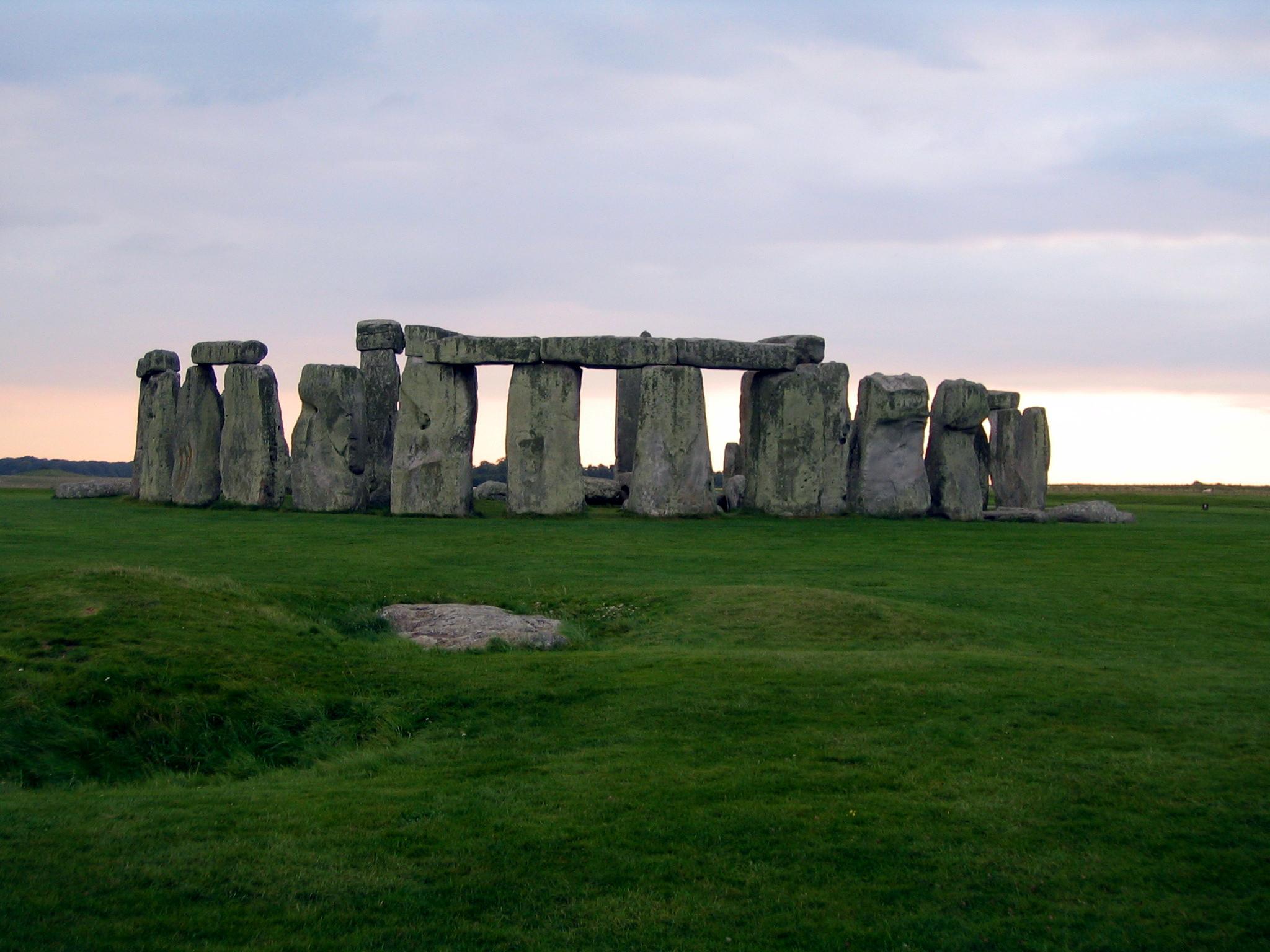 Figure \(\PageIndex{10}\): Stonehenge continues to provide clues to its mysterious existence with recent research using isotope ratios.
Figure \(\PageIndex{10}\): Stonehenge continues to provide clues to its mysterious existence with recent research using isotope ratios.Recent work involving stable isotope analysis has been done on the cremation burials from Stonehenge, in Wessex, England (Figure 7.37). Much of the archaeological work at Stonehenge in the past focused on the building and development of the monument itself. That is partly because most of the burials at the monument were cremated remains, which are difficult to study because of their fragmentary nature and the chemical alterations that bone and teeth undergo when heated. The cremation process complicates the oxygen and carbon isotopes. However, the researchers determined that strontium would not be affected by heating and could still be analyzed in cranial fragments. Using the remains of 25 individuals, they compared their strontium signatures to the geology of Wessex and other regions of the UK. Fifteen of those individuals had strontium signatures that matched the local geology. This means that in the last ten or so years of their lives, they lived and ate food from around Stonehenge. However, ten of the individuals did not match the local geologic signature. These individuals had strontium ratios more closely aligned with the geology of west Wales. Archaeologists find this particularly interesting because in the early phases of Stonehenge’s construction, the smaller “blue stones” were brought 200 km from Wales in a feat of prehistoric engineering. These larger regional connections show that Stonehenge was not just a site of local importance. It dominated a much larger region of influence and drew people from all over ancient Britain (Snoeck et al. 2018).
SPECIAL TOPIC: COLD CASE NAIA
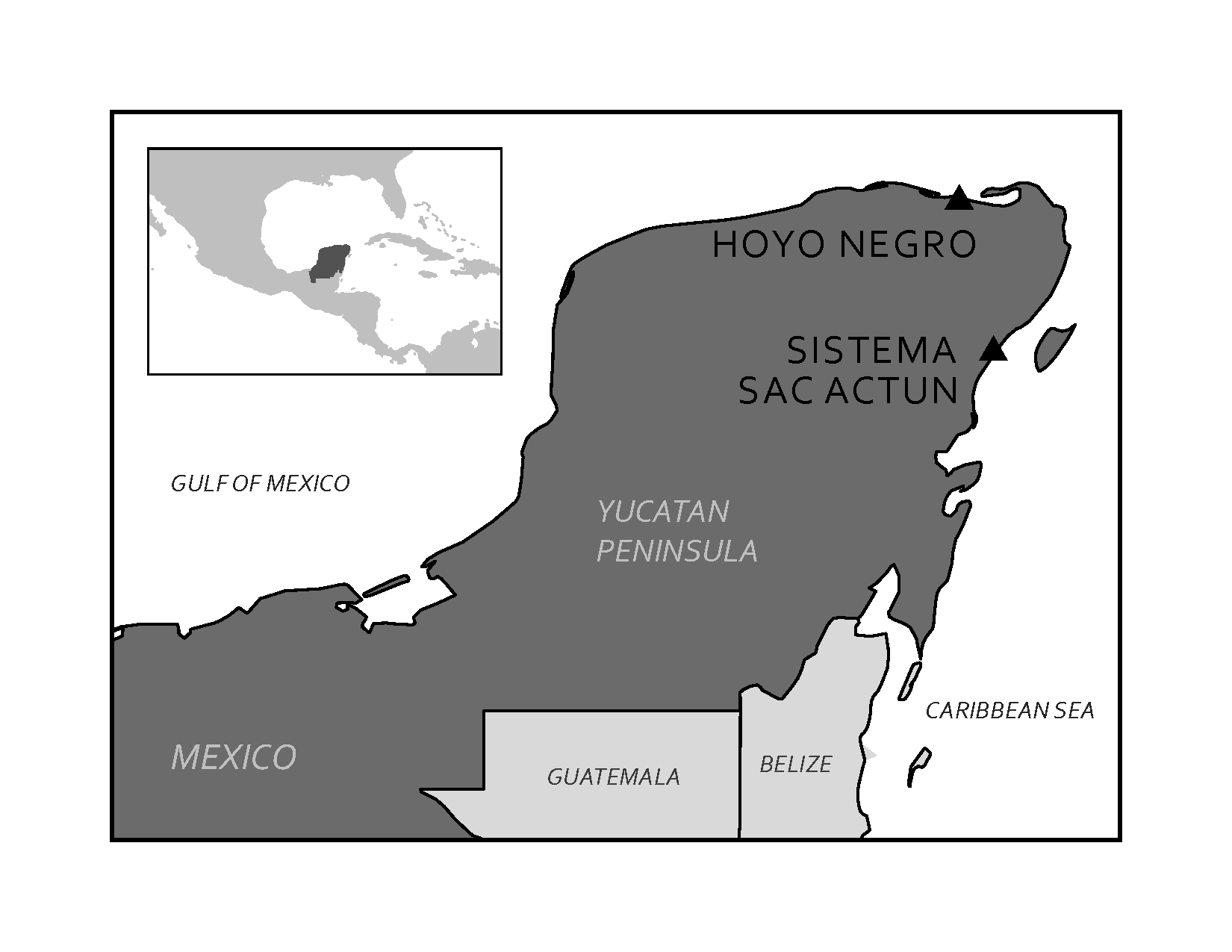 Figure \(\PageIndex{11}\): Map of Mexico showing the Yucatan Peninsula and the locations of Hoyo Negro and Sistema Sac Actun.
Figure \(\PageIndex{11}\): Map of Mexico showing the Yucatan Peninsula and the locations of Hoyo Negro and Sistema Sac Actun.In 2007, cave divers exploring the Sistema Sac Actun in the Yucatán Peninsula in Mexico (see Figure 7.38) discovered the bones of a 15- to 16-year-old female human along with the bones of various extinct animals from the Pleistocene (Figures 7.39 and 7.40) (Collins et al. 2015). The site was named Hoyo Negro (“Black Hole”). The human bones belonged to a Paleoindian, later named “Naia” after a Greek water nymph. Examination of the partially fossilized remains revealed a great deal about Naia’s life, and the radiocarbon dating of her tooth enamel indicated that she lived some 11,000 years ago (Chatters et al. 2014). Naia’s arms were not overly developed, so her daily activities did not involve heavy carrying or grinding of grain or seeds. Her legs, however, were quite muscular, implying that Naia was used to walking long distances. Naia’s teeth and bones indicate habitually poor nutrition. There is evidence of violent injury during the course of Naia’s life from a healed spiral fracture of her left forearm. Naia also suffered from tooth decay and osteoporosis even though she appeared young and undersize. Dr. Jim Chatters hypothesizes that Naia entered the cave at a time when it was not flooded, probably looking for water. She may have become disoriented and fell off a high ledge to her death. The trauma to her pelvis is consistent with such an injury (Watson 2017).
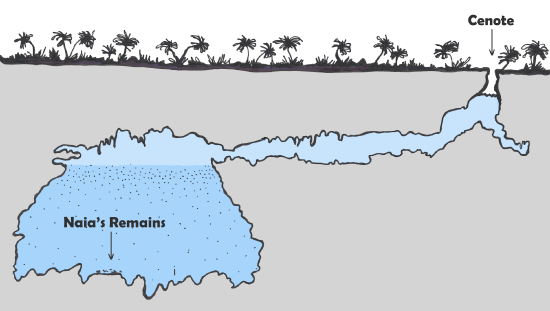 Figure \(\PageIndex{12}\): A diagram of the Sistema Sac Actun and the Hoyo Negro cenote where Naia rested underwater for roughly 13,000 years.
Figure \(\PageIndex{12}\): A diagram of the Sistema Sac Actun and the Hoyo Negro cenote where Naia rested underwater for roughly 13,000 years.Although Naia’s skeleton is incomplete, it is more complete than any other “New World skeleton” ever found. As divers were able to locate her skull, Naia’s physical appearance in life could be interpreted. Surprisingly, in examining the skull, it was determined that Naia did not resemble modern Native Americans. However, themitochondrial DNA (mtDNA) recovered from a tooth indicates that Naia shares her DNA with modern Native Americans whose DNA has been linked conclusively to ancestors in Siberia. This means that Naia proves the theory that there was a migration over the land bridge known as Beringia after the last ice age and that the changes in craniofacial morphology are due to evolution after the migration (Chatters et al. 2014).
SUMMARY
With a timeline that extends back some 4.6 billion years, Earth has witnessed continental drift, environmental changes, and a growing complexity of life. Fossils, the mineralized remains of living organisms, provide physical evidence of life and the environment on the planet over the course of billions of years. Early fossil hunter Mary Anning had a profound influence on the way scholars, including Charles Darwin, interpreted evolutionary history. In order to better understand the fossil record, anthropologists rely on the collaboration of numerous academic fields and disciplines. Anthropologists use a variety of scientific methods, both relative and chronometric, to analyze fossils to determine age, origins, and migration patterns as well as to provide insight into the health and diet of the fossilized organism. While each method has its advantages, disadvantages, and limited applications, these tools enable anthropologists to theorize how all living organisms evolved, including the evolution of early humans into modern humans, H. sapiens. The fossil record is far from complete, but our expanding understanding of the fossil context, with exciting new discoveries and improved scientific methods, enables us to document the history of our planet and the evolution of life on Earth.
Review Questions
- In what ways did early paleontologists shape our modern methods of fossil extraction and analysis?
- What kind of information could you acquire from a single fossil? What could it tell you about the broader environment?
- What factors would you take into consideration when deciding which dating method to use for a particular artifact?
- How do stable isotopes help us reconstruct past environments and lifestyles?

